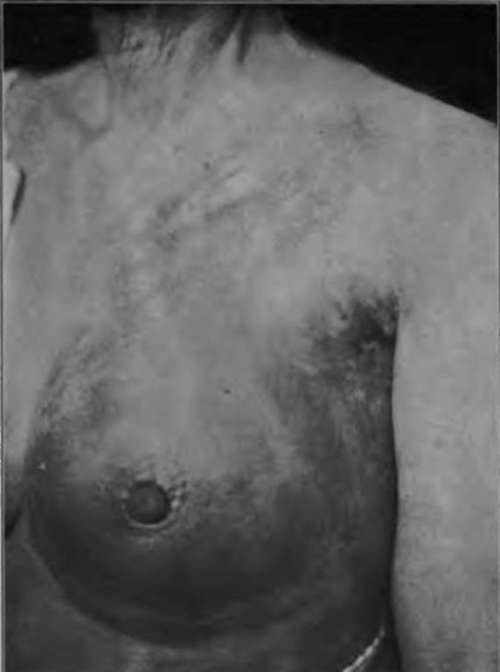Chapter X. Carcinoma En Cuirasse-Carcinoma By Extension- Metastatic Carcinoma-Paget's Disease
Description
This section is from the book "Skin Cancer", by Henry H. Hazen, A.B., M.D.. Also available from Amazon: Skin Cancer.
Chapter X. Carcinoma En Cuirasse-Carcinoma By Extension- Metastatic Carcinoma-Paget's Disease
Carcinoma En Cuirasse
Pollitzer* has recently written an excellent article on carcinoma of this type, and the author has drawn freely from it.
Just as in many other cancerous conditions, there are many degrees of involvement, and the author can see no reason for not calling even minor involvement of the lymphatics of the skin, causing induration, by the name of cancer en cuirasse, although marly will not accept this view.
Clinical Course
This type of cancer was first described by Vel-peau about seventy-five years ago, and fully developed instances are very rare. The trouble probably always begins in the glands of the breast, notwithstanding the statements of Rodman and Besnier to the contrary. In a typical case we find a breast cancer, with retraction of the nipple, and possibly all of the other signs of a typical mammary carcinoma, although the skin of the gland may be so indurated that it is impossible to palpate the primary tumor. Beginning in the breast, and extending from it over the chest and back, to a greater or less extent the skin is reddened, very hard and firm to the touch and feeling like a sclerodermatous cutis (Fig. 51). There may or may not be very numerous small angular or round papules present, but there are usually a few. These papules may resemble the lesions of lichen planus to a marked extent. Pollitzer says that in his case the appearance was that of a lichen planus developing upon a sclerodermatous area. The glands may or may not be involved, and the disease usually runs a comparatively slow course, about that of a slow-growing scirrhous carcinoma. Owing to the obstruction of the lymphatics, the arm may become markedly edematous. At times there is very intense itching over the diseased area, and movement is usually greatly limited and at times painful.
Pathology
The pathology of the condition is comparatively simple. Instead of passing through the lymph vessels, the cancer cells have grown into them in long, finger-like projections, almost completely filling the lumens. Very little of the cancerous tissue is found outside of the lymphatics. There is very little inflammatory reaction in the cutis; the blood vessels, glands and connective tissue are unchanged. The lichenoid papules arc due to a hyperacan-thosis over three or four of the papilla?, and not to the deposit of cancerous cells in the more superficial portions of the skin. The erythema is probably due to the effect of the toxins upon the vasomotors in a region in which the flow of lymph is obstructed. Certain of the nodules that can occasionally be felt deeper in the skin are due to accumulations and growth of cancer cells that have escaped from the lymphatics and started to grow in the connective tissue.
*Pollitzer: Jour. Cutan. Dis., 1909; xxvii, 143.

Fig. 51.-Carcinoma en culrasse.
Diagnosis
The diagnosis must be made from erysipelas, scleroderma, and lichen planus, and should be easy, provided that a careful examination is made. Especially should the nipples be examined for retraction, and the lesions carefully palpated.
Treatment
When this stage of cancer has been reached, the treatment consists simply in keeping the patient as comfortable as possible.
Continue to:
- prev: Nevocarcinomata And Malignant Melanomata (Malignant Pigmented Moles). Continued
- Table of Contents
- next: Carcinoma By Extension
Tags
bookdome.com, books, online, free, old, antique, new, read, browse, download
